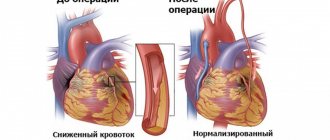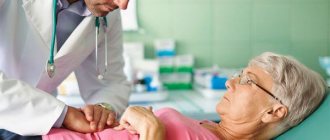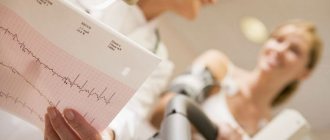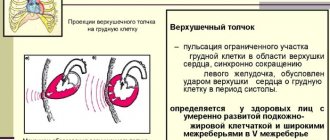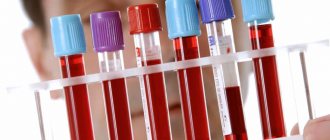Almost everyone perceives chest pain as a potential heart problem. However, there can be many reasons for discomfort. In any case, it is impossible to determine on your own what causes the discomfort. Only a qualified doctor can determine the cause.
Incorrect diagnosis, lack of treatment, and uncontrolled attempts to relieve pain at the site of discomfort often lead to the development of severe pathologies.
To make sure that pain is not a sign of serious illness or to select treatment for identified pathology, it is better to visit a doctor. The causes of pain can be caused by diseases of the heart, lungs, gastrointestinal tract and neurological problems. If you don’t know which doctor to make an appointment with first, come to the Kutuzov Diagnostic and Treatment Center. We have all the specialists who can help you make an accurate diagnosis. Start by making an appointment with your GP and follow their instructions.
Such different chest pains
Thoracalgia is a term for chest pain (from the words “thorax” - chest and “algia” - pain).
It can hurt either on one side of the chest or in the middle, in the upper or lower part. The nature of the pain is:
- Sharp and burning.
- Dull and aching.
- Stabbing.
- Compressive.
Among the main reasons for the appearance of a disturbing symptom in the chest are diseases, injuries and pathologies:
- Heart and blood vessels.
- Lungs.
- Musculoskeletal system - muscles, ribs and spine.
- Nervous system
- Gastrointestinal tract.
Let's look at them in more detail.
Diagnosis of the causes of pain in the mammary gland
- Consultation with a mammologist. After a thorough examination, the doctor can refer the patient to other specialists at our medical center - a gynecologist, endocrinologist, surgeon, oncologist, geneticist.
- Instrumental studies: ultrasound of the mammary glands;
- ductography (determining the patency of the ducts);
- digital and MR mammography.
- biopsy followed by histological examination;
Heart problems
Pain in the chest in the middle or on the left side occurs with various heart diseases:
- IHD, angina pectoris - a violation of blood flow in the heart arteries. Often an attack of sharp pain lasts up to 15 minutes. Occurs during physical activity, stress, anxiety, and goes away after rest.
- Myocardial infarction is the death of cells and the formation of scars on the heart muscle. It is characterized by severe pain in the chest on the left and in the middle, which does not go away after 15-20 minutes. Additional symptoms include weakness and fear of death.
- Pericarditis or myocarditis is an inflammatory process in the muscle or lining of the heart. They are characterized by acute or aching pain in the chest when inhaling in the middle of the chest, which intensifies while eating or lying down.
- Mitral valve prolapse - in addition to chest pain, it causes shortness of breath, dizziness, even fainting.
- Pulmonary hypertension is increased pressure in the pulmonary arteries, an attack similar to a heart attack.
A characteristic feature of heart pain is that it often occurs against a background of emotional or physical stress and is accompanied by a feeling of panic and fear of death.
Pain in the chest in the middle: causes
There can be many reasons why pain appears in the middle of the chest, so it is worth considering the intensity of the pain syndrome, its frequency and the specific location of the pain. By doing this, it will be possible to narrow down the search for pathology leading to unpleasant sensations.
Heart pathologies
Chest pain is often associated with diseases of the cardiovascular system and heart. If you feel thoracalgia all the time, this may indicate an aortic aneurysm. In this case, pain in the left or right side of the chest is felt for a long time, and it will become stronger whenever the person moves from rest to physical activity. The condition can only be treated surgically, so if this diagnosis is confirmed, hospitalization will be required. Pain in the center of the chest in front may also appear if pulmonary embolism develops. The pain becomes more severe when you inhale, and taking analgesics can suppress it. Compressive pain may indicate that a person has exertional angina, and pain may also be a symptom of myocardial infarction
.
Respiratory damage
If pain appears in the front center of the chest, and you feel shortness of breath, cannot breathe deeply, have a cough and shortness of breath, the problem may be the occurrence of pulmonary diseases, which include tracheitis, pneumonia, bronchitis, pleurisy and some others. The same symptoms can occur with diseases of the diaphragm.
Injuries
Pain in the front of the chest, in the middle, or between the ribs can occur in a person who has had an accident, been involved in a fight, or damaged the structure of the chest due to a fall or blow. Such pain intensifies when he tries to turn around, bend over, take a deep breath, and is explained by the fact that blood vessels rupture, the periosteum is damaged, cracks and fractures form. In such a situation, at rest, the pain syndrome can disappear almost completely, which gives a person false confidence that there is no need to see a doctor.
Spinal diseases
The most common reason why the chest hurts in the middle is osteochondrosis, if we talk about pathologies of the spinal column. Pain with osteochondrosis can be constant or manifest itself in the form of attacks. The pain will be of the same intensity and manifestation with radiculopathy in the thoracic spine. Pain syndrome may also indicate an intervertebral hernia and congenital anomalies in the structure of the spinal column.
Neurological diseases
The causes of pain in the chest in the middle can be neuralgic in nature. The most common diagnosis in this case is intercostal neuralgia, in which there is a lot of pain in the sternum, radiating to the back under the shoulder blade, which is why it is easy for a person to confuse the pain with heart pain.
Problems with the esophagus
Pain in the shoulder blades and in the middle of the chest may be associated with pathologies of the esophagus. The cause in this case is usually a spasm, which manifests itself more often in the morning or after eating. Pain in the chest area is relieved by taking antispasmodic drugs. Often spasms of the esophagus are accompanied by spasms of the muscular walls of the stomach.
Lung diseases
This is a common cause of chest discomfort. Main causes and characteristic symptoms:
- Inflammation or abscess of the lung - the process occurs with severe pain in the chest (right or both parts of the chest), fever, cough.
- Pleurisy (inflammation of the pleura) - pain appears when taking a deep breath, usually accompanied by an increase in body temperature and cough.
- Thromboembolism of the pulmonary artery with a blood clot - severe chest pain, tachycardia, difficulty breathing.
- Pneumothorax is the accumulation of air in the pleural cavity when the lungs are damaged due to injuries to the ribs and spine. Pain appears when inhaling, shortness of breath, dry cough, and blood pressure may decrease.
- Bronchial asthma - acute spasms occur with pain and wheezing in the chest, wet cough, attacks of difficulty breathing
Problem during pregnancy and breastfeeding
Pregnancy and the period of breastfeeding are characterized by changes in hormonal levels in the female body. This can lead to the development of various pathologies. Here are the main ones:
- Lactostasis. Formed due to stagnation of milk in the breast. Characteristic of the period immediately following childbirth. The breast becomes rough, compactions form in the tissues, the chest seems to be bursting from the inside, palpation brings a feeling of pain.
- Mastitis. The nature of the pathology is infectious. In the vast majority of cases, it develops during breastfeeding. One of the causes of the pathology is insufficient hygiene of the mammary glands. If pathology occurs, an increase in breast size, swelling, redness is noted, and upon palpation - a sharp pain syndrome. A feverish state and signs of intoxication may occur. As the inflammatory process develops, it produces compactions. Pathology can develop into an abscess or phlegmon.
It is not possible to understand what caused the lumps and pain on your own; a visit to the doctor and the necessary examination are necessary. And, of course, it is necessary to constantly monitor the condition of the mammary glands.
Gastrointestinal diseases
Major diseases that cause pain in the esophagus, or can spread from the abdomen to the chest area:
- Gastroesophageal reflux disease (GERD) is irritation of the esophageal mucosa due to the reflux of gastric contents.
- Dyskinesia or esophageal perforation is increased pressure in the esophagus due to slow movement of food or its rupture due to injury.
- Stomach ulcers.
Gastrointestinal diseases are characterized by pain that appears before, after or during meals; they may be accompanied by heartburn and other symptoms.
Treatment of breast pain
Treatment of painful sensations in the mammary gland is aimed at the underlying disease. The Clinical Hospital on Yauza provides treatment for identified mammary gland pathologies of any complexity:
- conservative drug treatment of breast diseases;
- surgical treatment, which includes sectoral resection of the mammary gland (organ-sparing surgery, without breast removal); radical mastectomy with removal of regional lymph nodes; plastic surgery (breast resizing, reconstruction, lift).
- chemotherapy - used in the presence of malignant neoplasms, breast cancer.
If you have any doubts about the health of the mammary glands, do not hesitate to consult a specialist mammologist. Even breast cancer detected at stage 1 is completely curable in 80% of cases and allows you to save the breast.
Injuries and diseases of the musculoskeletal system
Thoracalgia appears due to injuries, diseases of the spine, and worsens after physical activity. Main causes and symptoms:
- Osteochondrosis, hernias and protrusions of intervertebral discs in the thoracic spine, scoliosis - cause chest pain, which intensifies with movement or prolonged immobility.
- Rib fractures.
- Muscle spasms, sprains, intercostal neuralgia - cause pain in the chest on the right or left, depending on the location where the pathology occurred.
- Tietze's syndrome or inflammation of the costochondral joints.
- Neurological pain - from “pins and needles” in the chest to severe pain occurs due to mental disorders, with panic attacks.
Pain in the right or left side of the chest may have other causes: tumors in the lungs or mammary gland, herpes zoster and other diseases.
The doctor’s task is to make a timely and correct diagnosis. This will help: heart examinations, ultrasound, radiography and other diagnostic procedures.
Emergency medical care is needed if:
- Acute chest pain does not go away after 15 minutes and after rest.
- There is dizziness, shortness of breath, increased sweating, and palpitations.
In other cases, it is also advisable not to delay consulting a doctor for too long. Who to contact - a cardiologist, a neurologist, a gastroenterologist - depends on the symptoms. But it is not always possible to determine this on your own. In this case, start by consulting a therapist who will help you understand the issue and, if necessary, refer you to a specialist.
In other cases, it is also advisable not to delay consulting a doctor for too long. Who to contact - a cardiologist, a neurologist, a gastroenterologist - depends on the symptoms. But it is not always possible to determine this on your own. In this case, start by consulting a therapist who will help you understand the issue and, if necessary, refer you to a specialist. Be healthy!
Diagnosis of any disease requires modern equipment and extensive medical experience. Especially when it comes to chest pain.
Our clinic offers its patients a full range of medical tests using high-precision equipment. Our doctors select the most informative and safe diagnostic methods.
By contacting us, you can be sure that the cause of the pain will be determined as quickly and accurately as possible. High-tech diagnostic devices allow you to monitor the functioning of all organs and systems without causing you unnecessary discomfort.
We value our patients' time, so all consultations and procedures are by appointment. By booking a visit, you can be sure that the doctor will be waiting for you. Come to the clinic to find out the cause of your pain and discuss treatment options.
Which doctor should I contact?
If you are able to visit the clinic yourself, you can make an appointment with a GP
. He will determine the approximate cause of the pain and the direction of further search, and will also give you directions for diagnostic procedures and, if necessary, to specialized specialists. If there is acute pain in the middle of the chest, it is difficult and difficult to move, you cannot get out of bed without pain, call an ambulance. After examining you at home, a specialist will provide first aid and determine whether you need to be taken to the hospital.
Breast self-examination
Self-examination should be carried out regularly, at least once a month. It is better to do this at the same time during the menstrual cycle.
Self-examination should be divided into 2 stages:
- Inspection;
- Palpation.
Initially, it is necessary to examine the skin for changes in color, rashes, or “lemon peel” changes. During self-examination, it is important to pay attention to whether the mammary glands are symmetrical. If there are no differences or they are small, this is the norm. If significant asymmetry occurs suddenly, you should visit a doctor.
In addition to examining the breasts, you need to make sure there are no retractions. To do this you need to raise your hands up. If retractions are present, then we can speak of suspicion of cancer.
After inspection, palpation follows. To carry it out, we raise our hand behind our head. And we conduct an examination around the chest (fingers flat). The goal is to study the entire mammary gland.
Of course, nipple discharge cannot be ignored. They can appear if you press on the nipple, plus you should pay attention to stains on clothes caused by discharge.
Healing procedures
The choice of treatment program is completely influenced by the cause of the problem.
The main task of combating lactostasis is to free the breasts from milk. A woman needs to massage her breasts, not get too cold, and feed the baby in a timely manner. It is important to eat well and rest; it is preferable to sleep on your side.
Mastitis is treated with antibiotic therapy. A properly selected treatment program can remove the seal.
When a doctor encounters purulent mastitis, surgical intervention is necessary.
For mastopathy, conservative methods are used. Various drugs, such as inhibitors, are used in therapy. Their task is to normalize hormonal levels.
When a doctor encounters a benign lump, a decision is usually made about surgical manipulation. This is more effective than therapeutic methods. Enucleation or sectoral resection is used.
Thrombocytopenia
Oncological tumors are treated only through surgery. Typically, a mastectomy is performed. In the process, regional lymph nodes are removed.
Sometimes the tumor is excised within healthy tissue.
As an alternative to treatment, chemotherapy, radiation therapy, and targeted therapy are used. The effect is enhanced if they complement each other.


